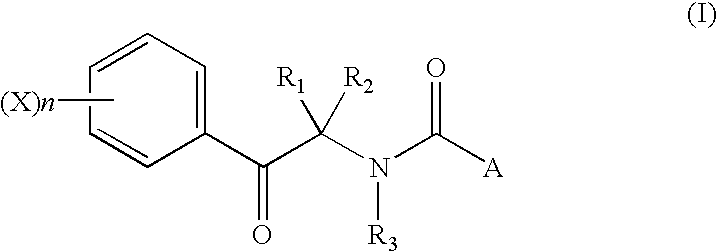Phenacylamine derivatives, process for their production and pesticides containing them
- Summary
- Abstract
- Description
- Claims
- Application Information
AI Technical Summary
Benefits of technology
Problems solved by technology
Method used
Image
Examples
preparation example 2
Preparation of 2-chloro-N-[(4′-chloro-1,1-dimethyl)phenacyl]benzamide (Compound No. 1-54)
[0087](1) A mixture comprising 5.92 g of 4-chloroisobutyrophenone, 19.5 g of N,N-dimethylhydrazin and 29.6 g of molecular sieve (3A) was reacted in an autoclave at 100° C. for 110 hours. The reaction mixture was diluted with methylene chloride, followed by filtration. The filtrate was dried over anhydrous magnesium sulfate, followed by concentration under reduced pressure to obtain 5.82 g of oily 4-chloroisobutyrophenone dimethylhydrazone. The NMR spectrum data of this product were as follows.
[0088]1H-NMR δ ppm (Solvent: CDCl3 / 400 MHz) 1.05 (d, 6H), 2.31 (bs, 6H), 2.85 (m, 1H), 7.14 (d, 2H), 7.32 (d, 2H)
[0089](2) 7.82 g of methyl iodide was added to a mixture comprising 5.82 g of 4-chloroisobutyrophenone dimethylhydrazone and 3.5 ml of absolute ethanol and reacted at room temperature for 15 hours. The reaction mixture was concentrated under reduced pressure, and ethyl ether was added to the obta...
preparation example 3
Preparation of 3,5-dichloro-N-[(4′-chloro-1,1-dimethyl)phenacyl]benzamide (Compound No. 1-63)
[0095]At room temperature, 0.47 g of triethylamine and then 0.44 g of 3,5-dichlorobenzoyl chloride, were added to a mixture comprising 0.49 g of α-amino-4-chloroisobutyrophenone hydrochloride and 14 ml of dichloroethane and reacted at the same temperature for 15 hours. The reaction mixture was washed with water and dried over anhydrous sodium sulfate, followed by concentration under reduced pressure. To the obtained residue, n-hexane was added, and the solid was collected by filtration and dried to obtain 0.46 g of the desired product having a melting point of from 169 to 171° C. The NMR spectrum data of this product were as follows.
[0096]1H-NMR δ ppm (Solvent: CDCl3 / 400 MHz) 1.79 (s, 6H), 7.04 (s, 1H), 7.36 (dd, 2H), 7.50 (s, 1H), 7.54 (d, 2H), 7.91 (dd, 2H)
preparation example 4
Preparation of 2-chloro-N-[(3′,4′-dichloro-1,1-dimethyl)phenacyl]benzamide (Compound No. 1-78)
[0097]At room temperature, a mixture comprising 0.215 g of N,N′-dicyclohexylcarbodiimide and 7 ml of dichloromethane, was dropwise added to a mixture comprising 0.22 g of α-amino-3,4-dichloroisobutyrophenone, 0.148 g of 2-chlorobenzoic acid and 8 ml of dichloromethane, and reacted at the same temperature for 20 hours. The reaction mixture was washed with water and dried over anhydrous sodium sulfate, followed by concentration under reduced pressure. The obtained residue was purified by silica gel column chromatography (developing solvent: ethyl acetate / n-hexane=3 / 7) to obtain 0.26 g of the desired product having a melting point of from 116 to 120° C. The NMR spectrum data of this product were as follows.
[0098]1H-NMR δ ppm (Solvent: CDCl3 / 400 MHz) 1.76 (s, 6H), 6.89 (s, 1H), 7.25-7.29 (m, 1H), 7.33-7.37 (m, 2H), 7.42-7.46 (m, 2H),7.87 (dd, 2H), 8.15 (d, 2H)
PUM
| Property | Measurement | Unit |
|---|---|---|
| Fraction | aaaaa | aaaaa |
| Fraction | aaaaa | aaaaa |
| Fraction | aaaaa | aaaaa |
Abstract
Description
Claims
Application Information
 Login to View More
Login to View More - R&D
- Intellectual Property
- Life Sciences
- Materials
- Tech Scout
- Unparalleled Data Quality
- Higher Quality Content
- 60% Fewer Hallucinations
Browse by: Latest US Patents, China's latest patents, Technical Efficacy Thesaurus, Application Domain, Technology Topic, Popular Technical Reports.
© 2025 PatSnap. All rights reserved.Legal|Privacy policy|Modern Slavery Act Transparency Statement|Sitemap|About US| Contact US: help@patsnap.com



